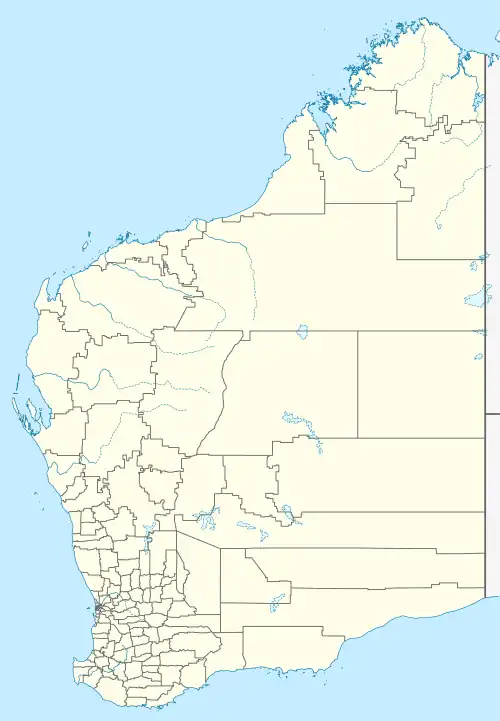| Mundrabilla Western Australia | |||||||||
|---|---|---|---|---|---|---|---|---|---|
.jpg.webp) Mundrabilla Roadhouse, 2017 | |||||||||
 Mundrabilla | |||||||||
| Coordinates | 31°49′3.70″S 128°13′31.19″E / 31.8176944°S 128.2253306°E | ||||||||
| Population | 11 (SAL 2021)[1] | ||||||||
| Established | 1872 | ||||||||
| Postcode(s) | 6443 | ||||||||
| Elevation | 20 m (66 ft) | ||||||||
| Area | 6,292 km2 (2,429 sq mi) | ||||||||
| Location | |||||||||
| LGA(s) | Shire of Dundas | ||||||||
| State electorate(s) | Eyre | ||||||||
| Federal division(s) | O'Connor | ||||||||
| |||||||||
Mundrabilla is in a very sparsely populated area in the far south east of Western Australia. The two significant features are Mundrabilla Roadhouse and Mundrabilla Station, which are approximately 35 kilometres (22 mi) apart. At the 2016 census, Mundrabilla had a population of 23, 32% male and 68% female.[2] The time zone in use is UTC+08:45.[3]
Mundrabilla Roadhouse
Mundrabilla Roadhouse was built by Roger and Pat Warren-Langford, who initially managed Mundrabilla Station. It is now a small roadhouse community located on the Eyre Highway in Western Australia, on the Roe Plains (at a lower level and south of the Nullarbor Plain), 66 kilometres (41 mi) west of Eucla and about 20 kilometres (12 mi) north of the Great Australian Bight.
Mundrabilla Station
Mundrabilla Station (31°50′34.55″S 127°51′25.09″E / 31.8429306°S 127.8569694°E), the first sheep station in the Nullarbor region, was established by William Stuart McGill (a Scotsman) and Thomas and William Kennedy (two Irishmen) in 1872. Thomas Kennedy died in 1896. McGill's first wife Annie Harkness (née Crawford) died in childbirth in 1879. Annie McGill and Thomas Kennedy are both buried on Mundrabilla Station. McGill remarried Ellen Angel Fairweather of Adelaide in 1889.
Climate
Mundrabilla has a typical arid climate; however it is cooler in summer than much of the Australian desert due to its proximity to the ocean. Despite this, Mundrabilla Station still holds the record for the equal 6th-hottest temperature in Australia, 49.8 °C (121.6 °F) recorded on 3 January 1979.[4]
| Climate data for Mundrabilla Station | |||||||||||||
|---|---|---|---|---|---|---|---|---|---|---|---|---|---|
| Month | Jan | Feb | Mar | Apr | May | Jun | Jul | Aug | Sep | Oct | Nov | Dec | Year |
| Record high °C (°F) | 49.8 (121.6) |
48.6 (119.5) |
44.8 (112.6) |
40.4 (104.7) |
36.4 (97.5) |
27.6 (81.7) |
30.1 (86.2) |
33.5 (92.3) |
39.0 (102.2) |
43.1 (109.6) |
46.0 (114.8) |
45.7 (114.3) |
49.8 (121.6) |
| Mean daily maximum °C (°F) | 29.6 (85.3) |
29.4 (84.9) |
27.4 (81.3) |
26.0 (78.8) |
22.2 (72.0) |
19.5 (67.1) |
19.2 (66.6) |
20.5 (68.9) |
22.5 (72.5) |
25.5 (77.9) |
27.3 (81.1) |
28.7 (83.7) |
24.8 (76.6) |
| Mean daily minimum °C (°F) | 15.7 (60.3) |
15.9 (60.6) |
14.7 (58.5) |
12.5 (54.5) |
10.3 (50.5) |
8.0 (46.4) |
7.0 (44.6) |
7.3 (45.1) |
8.3 (46.9) |
10.5 (50.9) |
12.2 (54.0) |
13.7 (56.7) |
11.3 (52.3) |
| Record low °C (°F) | 8.3 (46.9) |
3.9 (39.0) |
7.3 (45.1) |
4.2 (39.6) |
2.7 (36.9) |
0.1 (32.2) |
−1.0 (30.2) |
−0.2 (31.6) |
−1.2 (29.8) |
0.2 (32.4) |
2.7 (36.9) |
6.5 (43.7) |
−1.2 (29.8) |
| Average rainfall mm (inches) | 15.9 (0.63) |
19.2 (0.76) |
19.3 (0.76) |
21.4 (0.84) |
25.9 (1.02) |
25.9 (1.02) |
22.2 (0.87) |
22.9 (0.90) |
18.8 (0.74) |
18.3 (0.72) |
16.0 (0.63) |
18.2 (0.72) |
244 (9.61) |
| Average rainy days (≥ 0.2mm) | 2.6 | 3.3 | 4.6 | 5.2 | 7.8 | 8.2 | 7.7 | 7.2 | 5.6 | 4.2 | 3.5 | 3.2 | 63.1 |
| Source: Bureau of Meteorology[5] | |||||||||||||
Present day
Like other locations in the Nullarbor Plain area, the area consists of nothing more than a roadhouse, open 6:00am to 9:30pm each day. The roadhouse includes a small wildlife park with emus, camels and an aviary. Pastoral activities continue in the area.
Meteorite
The Mundrabilla meteorite, the largest meteorite found in Australia, weighing 12.4 tonnes, was found by geologists R.B. Wilson and A.M. Cooney during a geological survey at Mundrabilla in 1966, and forms one half of the "Mundrabilla Mass". The next largest fragment weighs 5.08 tonnes. In all, 22 tonnes of fragments have been recovered, spread over a 60 km range making it one of the largest meteorite sites in the world. The fragments fell to Earth at least one million years ago.[6][7]
See also
References
- ↑ Australian Bureau of Statistics (28 June 2022). "Mundrabilla (suburb and locality)". Australian Census 2021 QuickStats. Retrieved 28 June 2022.
- ↑ Australian Bureau of Statistics (27 June 2017). "Mundrabilla (State Suburb)". 2016 Census QuickStats. Retrieved 20 June 2018.
- ↑ "Australia's Weird Little Time Zone". 12 July 2008.
- ↑ "Official records for Australia". Daily Extremes. Bureau of Meteorology. 17 May 2021. Retrieved 25 May 2021.
- ↑ "Mundrabilla Station". Climate statistics for Australian locations. Bureau of Meteorology. April 2014. Retrieved 15 April 2014.
- ↑ "Mundrabilla iron meteorite (main mass 12.4 tonnes)". Western Australian Museum. Retrieved 20 June 2018.
- ↑ "Solar System information #6: Meteors and Meteorites". Perth Observatory. 1997–2009. Archived from the original on 12 November 2009. Retrieved 7 November 2009.
External links
![]() Media related to Mundrabilla, Western Australia at Wikimedia Commons
Media related to Mundrabilla, Western Australia at Wikimedia Commons
- Shire of Dundas – Towns of the Eyre Highway
- Nullarbor Net – Mundrabilla including local information.